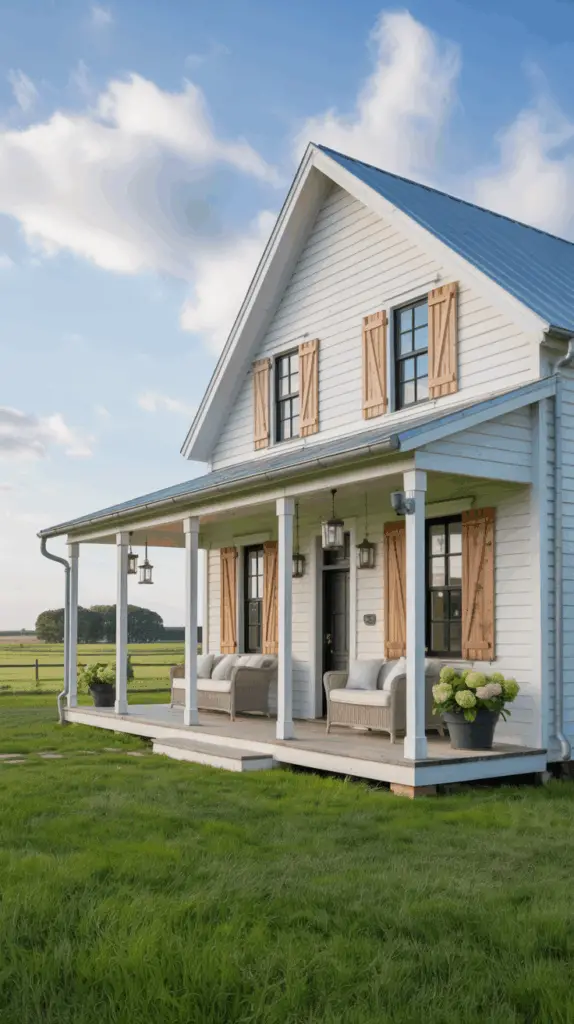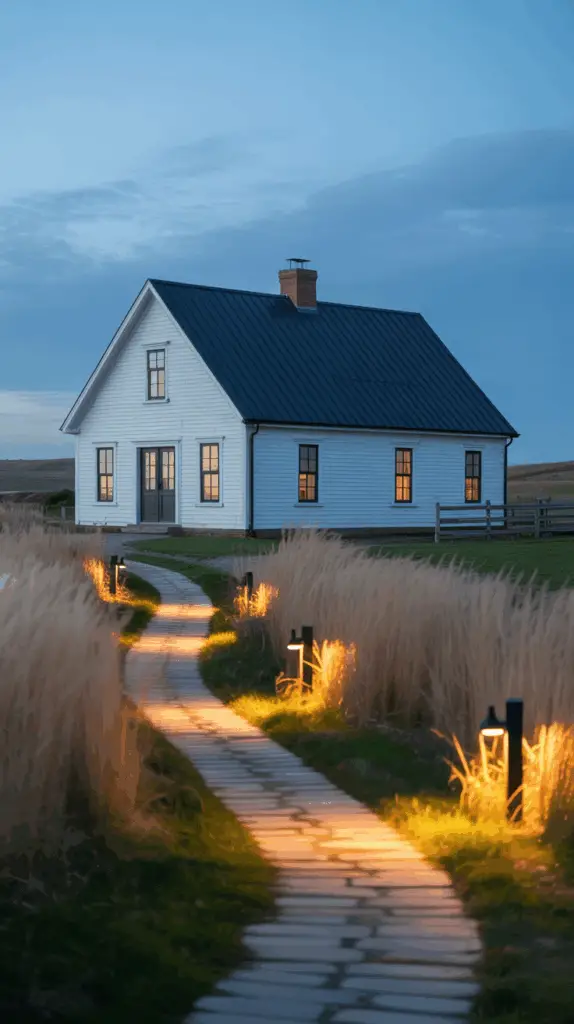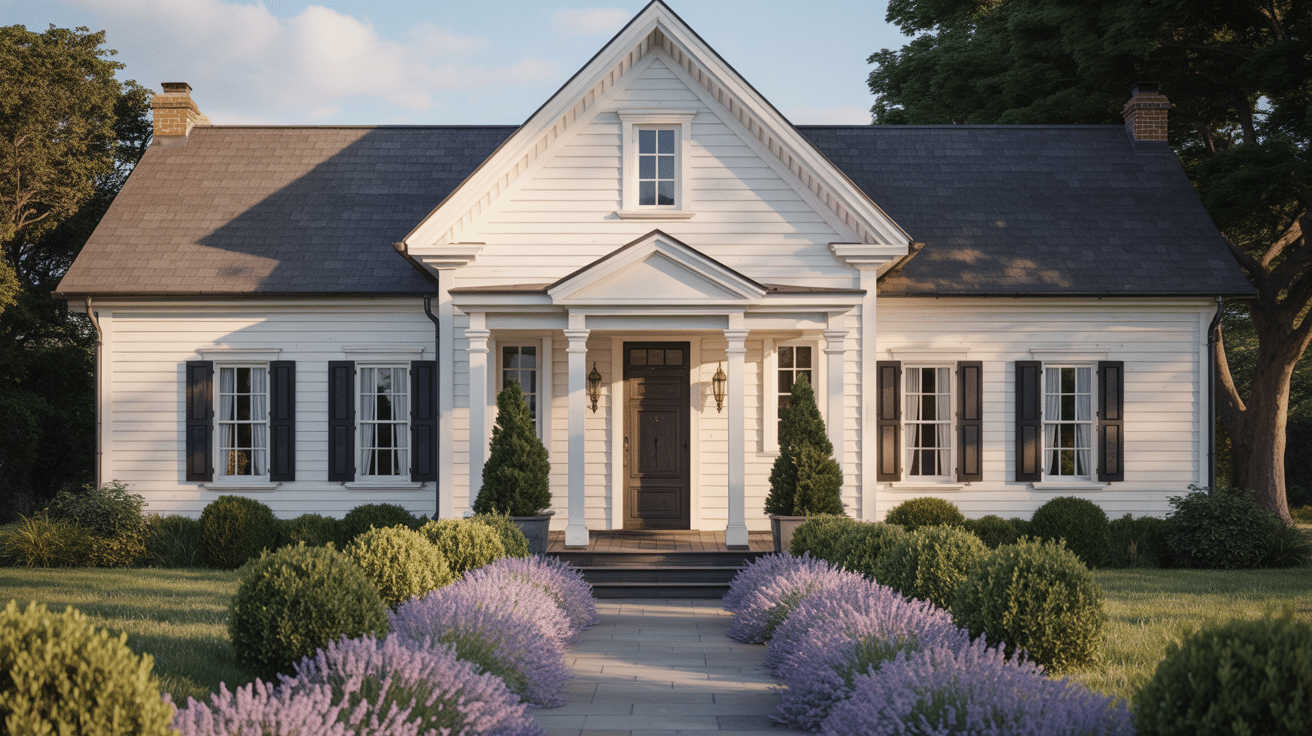How to Achieve the Perfect White Farmhouse Exterior Look for Timeless Curb Appeal
Table of Contents
Introduction
The white farmhouse exterior is a design icon—clean, classic, and full of character. With its crisp siding, black-trimmed windows, and warm wood accents, this timeless look blends old-world charm with modern simplicity. It’s no wonder that searches for “white farmhouse exterior” have surged in recent years, becoming a favorite among homeowners and designers alike.
But crafting the perfect white farmhouse exterior is about more than just painting your siding white. It’s a careful balance of color selection, texture, trim, roofing, architectural details, and landscaping. Each element contributes to a cohesive, welcoming presence that stands out while still feeling rooted in tradition.
Whether you’re building from scratch, remodeling an older home, or simply refreshing your facade, achieving that perfect white farmhouse exterior look takes thoughtful planning and design know-how. This article breaks down each component—from choosing the right white paint to incorporating wood accents, window styles, lighting, and outdoor elements. You’ll find inspiration, practical tips, and visual guidance to help you design an exterior that’s elegant, functional, and endlessly charming.
Let’s explore how to bring your dream farmhouse vision to life—starting from the curb.
Choose the Right Shade of White for Your Farmhouse Exterior
Not all whites are created equal. Choosing the right white paint for your farmhouse exterior is one of the most important design decisions you’ll make. The wrong shade can feel stark and cold, while the right one brings warmth, softness, and balance to the overall aesthetic.
Warm whites with creamy undertones tend to be the most inviting. Look for colors like Sherwin-Williams Alabaster, Benjamin Moore White Dove, or Behr Whisper White. These shades avoid harsh brightness and pair beautifully with natural wood, black accents, and metal roofing.
If your farmhouse has modern leanings or more angular architecture, cooler whites with subtle gray or blue undertones can create a crisp, refined effect—just be cautious in bright sunlight, where cooler whites can reflect a bluish cast.
Also, consider your region and surroundings. In wooded or rural settings, a warmer white blends more naturally. In coastal or desert areas, a brighter white might complement the light and open landscape.
Sampling is key. Always test multiple whites on your actual siding, in different lighting conditions—morning, midday, and evening. What looks soft and creamy in a store can appear stark and sterile in full sun.
Table: Popular White Exterior Paints and Their Undertones
| Paint Name | Brand | Undertone | Best For |
| Alabaster | Sherwin-Williams | Warm beige | Traditional or wooded settings |
| White Dove | Benjamin Moore | Creamy off-white | Balanced, soft contrast |
| Chantilly Lace | Benjamin Moore | Pure, cool white | Clean modern farmhouse look |
| Swiss Coffee | Behr | Warm, slight yellow | Sunny or Mediterranean climates |
Balance the Look with the Right Trim and Accents
Trim is the unsung hero of farmhouse exteriors—it frames the design, provides contrast, and adds polish to the overall look. When working with a white exterior, choosing the right trim and accent colors makes all the difference.
Black is the most popular trim color for white farmhouses, and for good reason. It offers bold contrast, crisp definition, and timeless appeal. Use black for window casings, shutters, gables, and light fixtures to ground the facade and create a modern edge.
For a softer or more traditional look, consider warm gray or greige trims. These shades still offer contrast but with less starkness than black. Wood trim or stained columns also complement white exteriors beautifully, bringing warmth and texture into the palette.
Consistency matters. If you’re mixing black metal with natural wood and white siding, keep all finishes coordinated across elements like lighting, house numbers, hardware, and porch railings. Repetition brings cohesion to the design.
Table: Trim and Accent Pairings for White Farmhouse Exteriors
| Trim Color | Accent Materials | Style Mood |
| Matte Black | Iron, steel, glass | Bold, modern, high contrast |
| Warm Gray | Copper, brick | Soft, vintage, cozy |
| Natural Wood | Cedar, oak | Organic, rustic charm |
| Bright White | Light neutrals | Clean, coastal, traditional |

Incorporate Rustic Wood Elements for Warmth and Texture
White farmhouse exteriors often walk a fine line between sleek and sterile. That’s where wood accents step in to restore balance and introduce warmth, depth, and rustic appeal. These elements also echo the agrarian roots of traditional farmhouses.
Consider adding wooden features like cedar porch columns, barn-style shutters, exposed rafter tails, or a stained wood front door. These touches bring earthiness and authenticity to your facade, especially when paired with natural landscaping or stone pathways.
A wooden accent wall under a gable or along the front porch can create a focal point. Using horizontal or vertical planks (like shiplap or board-and-batten) offers visual interest and dimensional texture without overwhelming the design.
Reclaimed or lightly distressed wood enhances the rustic look, while smoother finishes with rich stains add refinement. Sealing wood with a weather-resistant finish ensures longevity and prevents fading or warping over time.
Balance is key—use wood sparingly to highlight features without making the home look like a log cabin. The goal is to soften the white and add depth without losing the clean lines of the farmhouse aesthetic.
Table: Where to Use Wood Accents on White Farmhouse Exteriors
| Element | Wood Type Recommendation | Effect on Curb Appeal |
| Front Door | Stained oak or walnut | Welcoming, standout entry |
| Porch Columns | Cedar or fir | Rustic support with charm |
| Shutters | Reclaimed barn wood | Authentic farmhouse touch |
| Gable Trim | Painted or natural pine | Architectural depth |
Choose the Best Roofing and Lighting for Farmhouse Character
The roof is often overlooked in exterior design, but it plays a crucial role in shaping the farmhouse style. For a white farmhouse exterior, the roofing material and color can either sharpen the aesthetic or soften it depending on your design goals.
Metal roofs are a farmhouse favorite, especially in matte black, charcoal, or galvanized finishes. They add texture, resist weathering, and align with the utilitarian roots of rural architecture. Standing seam metal roofs, in particular, give a sleek yet timeless profile.
If you prefer a more traditional approach, architectural shingles in neutral shades like weathered gray, slate, or driftwood also complement white exteriors beautifully. Be sure to match roofing trim and gutters for consistency.
Exterior lighting is another layer of character and functionality. Black iron lantern sconces, gooseneck barn lights, or vintage-style pendants work seamlessly with the farmhouse aesthetic. Opt for fixtures with clear glass and warm bulbs to cast a welcoming glow in the evenings.
Lighting should be placed strategically—near entryways, along pathways, or on porch ceilings—to highlight architectural details and improve safety. Integrating lighting with smart controls or dusk-to-dawn sensors adds modern convenience to your rustic charm.
Table: Roofing and Lighting Elements for White Farmhouse Exteriors
| Feature | Style Suggestion | Benefit to Overall Design |
| Metal Roof | Standing seam, matte finish | Modern-rustic blend |
| Shingle Roof | Slate gray or weathered wood | Classic, understated appeal |
| Porch Lighting | Black gooseneck, lanterns | Warm, welcoming ambiance |
| Path Lights | Ground stakes, low voltage | Highlights landscaping |

Frame the Home with Timeless Farmhouse Landscaping
No white farmhouse exterior is complete without a landscape that reflects its timeless charm. While modern gardens may lean toward minimalism, farmhouse landscaping embraces lush greenery, simple lines, and native or seasonal plants that feel at home with nature.
Start by softening the base of your home with foundation plantings. Think boxwoods, hydrangeas, lavender, or ornamental grasses. These frame the house and add color without overwhelming the architecture. Keep plant beds tidy and symmetrical for that curated, yet organic, farmhouse feel.
Gravel or flagstone paths lend rustic texture and guide the eye toward entry points. Line them with herbs or low hedges for structure. A white picket fence or split-rail boundary adds rural charm and a sense of enclosure.
Add interest with vintage planters, galvanized buckets, or whiskey barrel pots filled with flowers or seasonal arrangements. Porch steps can be accented with potted ferns in the summer or pumpkins and lanterns in the fall.
Remember that farmhouse design celebrates functionality, so consider raised garden beds, a trellis with climbing roses, or a small herb garden—beautiful and practical additions.
Table: Essential Landscaping Features for Farmhouse Exteriors
| Element | Recommended Plants/Materials | Contribution to Aesthetic |
| Foundation Planting | Boxwood, hydrangea, salvia | Frames structure, adds softness |
| Walkways | Gravel, stone, brick | Rustic charm, guides flow |
| Fencing | White picket or split rail | Classic, inviting boundary |
| Porch Decor | Ferns, lanterns, planters | Seasonal color and warmth |
Conclusion
Achieving the perfect white farmhouse exterior look is all about balance—between warmth and contrast, tradition and simplicity, texture and color. Each detail, from the paint shade to the porch lighting, contributes to a cohesive design that feels both timeless and personal.
By thoughtfully choosing your siding, trim, roofing, accents, and landscaping, you can create a home that radiates charm from the curb and welcomes guests with authentic style. Whether you’re starting a new build or refining an existing home, the white farmhouse exterior offers a canvas rich with opportunity to express rustic elegance in a way that never goes out of style.

